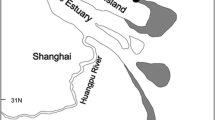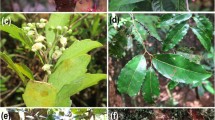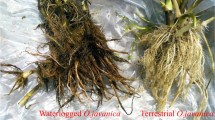Abstract
Plants growing on polluted soils need to control the bioavailability of pollutants to reduce their toxicity. This study aims to reveal processes occurring at the soil-root interface of Pistacia lentiscus L. growing on the highly Zn-contaminated tailings of Campo Pisano mine (SW Sardinia, Italy), in order to shed light on possible mechanisms allowing for plant adaptation. The study combines conventional X-ray diffraction (XRD) and scanning electron microscopy (SEM) with advanced synchrotron-based techniques, micro-X-ray fluorescence mapping (μ-XRF) and X-ray absorption spectroscopy (XAS). Data analysis elucidates a mechanism used by P. lentiscus L. as response to high Zn concentration in soil. In particular, P. lentiscus roots take up Al, Si and Zn from the rhizosphere minerals in order to build biomineralizations that are part of survival strategy of the species, leading to formation of a Si-Al biomineralization coating the root epidermis. XAS analysis rules out Zn binding to organic molecules and indicates that Zn coordinates Si atoms stored in root epidermis leading to the precipitation of an amorphous Zn-silicate. These findings represent a step forward in understanding biological mechanisms and the resulting behaviour of minor and trace elements during plant-soil interaction and will have significant implications for development of phytoremediation techniques.






Similar content being viewed by others
Notes
Error Reporting Recommendations: A Report of the Standards and Criteria Committee, July 26, 2000—www.ixasportal.net/ixas/images/ixas_mat/Error_Reports_2000.pdf)
References
Audet P, Charest C (2007) Dynamics of arbuscular1 mycorrhizal symbiosis in heavy metal phytoremediation: meta-analytical and conceptual perspectives. Environ Pollut 147:609–614
Aversa G, Balassone G, Boni M, Amalfitano (2002) Themineralogy of the “Calamine” ores in SW Sardinia (Italy): preliminary results. Period Mineral 71:201–218
Bacchetta G, Cao A, Cappai G, Carucci A, Casti M, Fercia ML, Lonis R, Mola F (2012) A field experiment on the use of Pistacia lentiscus L. and Scrophularia canina L. subsp. bicolor (Sibth. Et Sm.) Greuter for the phytoremediation of abandoned mining areas. Plant Biosyst 146:1054–1063
Bacchetta G, Cappai G, Carucci A, Tamburini E (2015) Use of native plants for the remediation of abandoned mine sites in Mediterranean semiarid environments. Bull Environ Contam Toxicol. doi:10.1007/s00128-015-1467-y
Baker AJM (1981) Accumulators and excluders strategies in the response of plants to heavy metals. J Plant Nutr 3:643–654
Bauer P, Elbaum R, Weiss IM (2011) Calcium and silicon mineralization in land plants: transport, structure and function. Plant Sci 180:746–756
Benfatto M, Meneghini C (2015) A close look into the low energy region of the XAS spectra: the XANES region. In: Mobilio S, Boscherini F, Meneghini C (eds) Synchrotron radiation, basics, methods and applications. Springer, Berlin Heidelberg, pp 213–240
Billows E (1941) I minerali della Sardegna ed i loro giacimenti: Rendiconti Università di Cagliari, p 331–335
Boni M, Gilg A, Aversa G, Balassone G (2003) The “Calamine” of SW Sardinia (Italy): geology, mineralogy and stable isotope geochemistry of a supergene Zn-mineralisation. Econ Geol 98:731–748
Caldelas C, Dong S, Araus JL, Jakob Weiss D (2011) Zinc isotopic fractionation in Phragmites australis in response to toxic levels of zinc. J Exp Bot 62:2169–2178
Chaoui A, Mazhoudi S, Ghorbal MH, Elferjani E (1997) Cadmium and zinc induction of lipid peroxidation and effects on antioxidant enzyme activities in bean (Phaseolus vulgaris L.). Plant Sci 127:139–147
Concas S, Lattanzi P, Bacchetta G, Barbafieri M, Vacca A (2015, submitted) Zn, Pb and Hg contents of Pistacia lentiscus L. grown on heavy-metal rich soils: implications for phytostabilization. Water Air Soil Poll
De Giudici G, Lattanzi P, Medas D (2015) Synchrotron radiation and environmental sciences synchrotron radiation. In: Mobilio S, Boscherini F, Meneghini C (eds) Synchrotron radiation, basics, methods and applications. Springer, Berlin Heidelberg, pp 661–676
De Vivo B, Boni M, Costabile S (1998) Formational anomalies versus mining pollution: geochemical risk maps of Sardinia, Italy. J Geochem Explor 64:321–337
De Vos CHR, Schat H, De Waal MAM, Voorja R, Ernst WHO (1991) Increased resistance to copper-induced damage of root cell plasmalemma in copper tolerant Silene cucubalus. Physiol Plant 82:523–528
Doncheva S, Stoyanova Z, Velikova V (2001) The influence of succinate on zinc toxicity of pea plant. J Plant Nutr 24:789–806
Dong J, Mao WH, Zhang GP, Cai Y (2007) Root excretion and plant tolerance to cadmium toxicity. Plant Environ J 53:193–200
dos Reis SP, Lima AM, de Souza CRBS (2012) Recent molecular advances on downstream plant responses to abiotic stress. Int J Mol Sci 13:8628–8647
Gardea-Torresdey JL, Arteaga S, Tiemann KJ, Chianelli R, Pingitore N, Mackay W (2001) Absorption of copper(II) by creosote bush (Larrea tridentata): use of atomic and x-ray absorption spectroscopy. Environ Toxicol Chem 20:2572–2579
Gardea-Torresdey JL, Videa JRP, Rosa GD, Parsons J (2005) Phytoremediation of heavy metals and study of the metal coordination by X-ray absorption spectroscopy. Coord Chem Rev 249:1797–1810
Gianoncelli A, Morrison GR, Kaulich B, Bacescu D, Kovac J (2006) A fast read-out CCD camera system for scanning X-ray microscopy. Appl Phys Lett 89:251117–251119
Gianoncelli A, Kaulich B, Alberti R, Klatka T, Longoni A, de Marco A, Marcello A, Kiskinova M (2009) Simultaneous soft X-ray transmission and emission microscopy. Nucl Instrum Methods 608:195–198
Gianoncelli A, Kourousias G, Stolfa A, Kaulich B (2013) Recent developments at the TwinMic beamline at ELETTRA: an 8 SDD detector setup for low energy X-ray. J Phys Conf Ser 425:182001
ICSD (Inorganic Crystal Structure Database) http://icsd.ill.eu/icsd/index.php, 2011
Jenks MA, Hasegawa PM (2014) Plant abiotic stress, 2nd edn. Wiley-Blackwell Publishing Inc, Oxford
Joner EJ, Briones R, Leyval C (2000) Metal-binding capacity of arbuscular mycorrhizal mycelium. Plant Soil 226:227–234
Kaulich B, Bacescu D, Susini J, David C, Di Fabrizio E, Morrison GR, Charalambous P, Thieme J, Wilhein T, Kovac J, Cocco D, Salome M, Dhez O, Weitkamp T, Cabrini S, Cojoc D, Gianoncelli A, Vogt U, Podnar M, Zangrando M, Zacchigna M, Kiskinova M (2006) Proc. 8th Int. Conf. X-ray Microscopy IPAP Conf. Series 7, 22
Kidd PS, Barceló J, Bernal MP, Navari-Izzo F, Poschenrieder C, Shilev S, Clemente R, Monterroso C (2009) Trace element behaviour at the root-soil interface: implications in phytoremediation. Environ Exp Bot 67:243–259
Larcher W (2003) Physiological plant ecology: ecophysiology and stress physiology of functional groups. Springer, Germany
Majumdar S, Peralta-Videa JR, Castillo-Michel H, Hong J, Rico CM, Gardea-Torresdey JL (2012) Applications of synchrotron μ-XRF to study the distribution of biologically important elements in different environmental matrices: a review. Anal Chim Acta 755:1–16
Malamy JE (2005) Intrinsic and environmental response pathways that regulate root system architecture. Plant Cell Environ 28:67–77
Manara A (2012) Plant responses to heavy metal toxicity. In: Antonella F (ed) Plants and Heavy Metals, SpringerBriefs in Molecular Science. Springer, Netherlands, pp 27–53
Medas D, Lattanzi P, Podda F, Meneghini C, Trapananti A, Sprocati A, Casu MA, Musu E, De Giudici G (2014) The amorphous Zn biomineralization at Naracauli stream, Sardinia: electron microscopy and X-ray absorption spectroscopy. Environ Sci Pollut R 21:6775–6782
Medas D, De Giudici G, Casu MA, Musu E, Gianoncelli A, Iadecola A, Meneghini C, Tamburini E, Sprocati AR, Turnau K, Lattanzi P (2015) Microscopic processes ruling Zn bioavailability to roots of Euphorbia pithyusa L. pioneer plant. Environ Sci Technol 49:1400–1408
Meneghini C, Bardelli F, Mobilio S (2012) ESTRA-FitEXA: a software package for EXAFS data analysis. Nucl Inst Methods B 285:153–157
Moore JMCM (1972) Supergene mineral deposits and physiographic development in southwest Sardinia, Italy. T I Min Metall B 71:B59–B66
Morrison GR, Gianoncelli A, Kaulich B, Bacescu D, Kovac J (2006) A fast read-out CCD system for configured-detector imaging in STXM. Conf Proc Series IPAP 7:277–379
Neumann D, De Figueiredo C (2002) A novel mechanism of silicon uptake. Protoplasma 220:59–67
Neumann D, zur Nieden U (2001) Silicon and heavy metal tolerance of higher plants. Phytochemistry 56:685–692
Padmavathiamma PK, Li LY (2007) Phytoremediation technology: hyper-accumulation metals in plants. Water Air Soil Poll 184:105–126
Rehr JJ, Albers RC (2000) Theoretical approaches to X-ray absorption fine structure. Rev Mod Phys 72:621–654
Rufyikiri G, Thiry Y, Declerck S (2003) Contribution of hyphae and roots to uranium uptake and translocation by arbuscular mycorrhizal carrot roots under root-organ culture conditions. New Phytol 158:391–399
Sole A, Papillon E, Cotte M, Walter P, Susini J (2007) A multiplatform code for the analysis of energy-dispersive X-ray fluorescence spectra. Spectrochim Acta B 62:63–68
Stara P, Rizzo R, Tanca GA (1996) Iglesiente-Arburese, miniere e minerali. Ente Minerario Sardo I
Sun F, Zhang W, Hu H, Li B, Wang Y, Zhao Y, Li K, Liu M, Li X (2008) Salt modulates gravity signalling pathway to regulate growth direction of primary roots in Arabidopsis. Plant Physiol 146:178–188
Turnau K, Ryszka P, Wojtczak G (2010) Metal tolerant mycorrhizal plants: a review from the perspective on industrial waste in temperate region. In: Koltai H, Kapulnik Y (eds) Arbuscular mycorrhizas: physiology and function. Springer, Netherlands, pp 257–276
van der Ent A, Baker AJ, Reeves RD, Chaney RL, Anderson CW, Meech JA, Erskine PD, Simonnot MO, Vaughan J, Morel JL, Echevarria G, Fogliani B, Rongliang Q, Mulligan DR (2015) Agromining: farming for metals in the future? Environ Sci Technol. doi:10.1021/es506031u
Acknowledgments
The study was financially supported by Regione Autonoma Sardegna (LR 7/2007 grant to P.L., Biophyto and SMERI projects) and MIUR (PRIN 2010–2011 Minerals-biosphere interaction).
Author information
Authors and Affiliations
Corresponding author
Additional information
Responsible editor: Philippe Garrigues
Electronic supplementary material
Below is the link to the electronic supplementary material.
Online Resource 1
(PDF 38 kb)
Online Resource 2
(PDF 159 kb)
Online Resource 3
(PDF 161 kb)
Rights and permissions
About this article
Cite this article
De Giudici, G., Medas, D., Meneghini, C. et al. Microscopic biomineralization processes and Zn bioavailability: a synchrotron-based investigation of Pistacia lentiscus L. roots. Environ Sci Pollut Res 22, 19352–19361 (2015). https://doi.org/10.1007/s11356-015-4808-9
Received:
Accepted:
Published:
Issue Date:
DOI: https://doi.org/10.1007/s11356-015-4808-9




